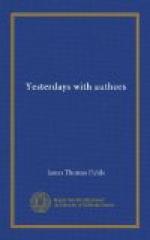Landor’s energetic gravity, when he was proposing some colossal impossibility, the observant novelist would naturally seize on, for Dickens was always on the lookout for exaggerations in human language and conduct. It was at Procter’s table I heard Dickens describe a scene which transpired after the publication of the “Old Curiosity Shop.” It seems that the first idea of Little Nell occurred to Dickens when he was on a birthday visit to Landor, then living in Bath. The old man was residing in lodgings in St. James Square, in that city, and ever after connected Little Nell with that particular spot. No character in prose fiction was a greater favorite with Landor, and one day, years after the story was published, he burst out with a tremendous emphasis, and declared the one mistake of his life was that he had not purchased the house in Bath, and then and there burned it to the ground, so that no meaner association should ever desecrate the birthplace of Little Nell!
It was Procter’s old schoolmaster (Dr. Drury, headmaster of Harrow) who was the means of introducing Edmund Kean, the great actor, on the London stage. Procter delighted to recall the many theatrical triumphs of the eccentric tragedian, and the memoir which he printed of Kean will always be read with interest. I heard the poet one evening describe the player most graphically as he appeared in Sir Giles Overreach in 1816 at Drury Lane, when he produced such an effect on Lord Byron, who sat that night in a stage-box with Tom Moore. His lordship was so overcome by Kean’s magnificent acting that he fell forward in a convulsive fit, and it was some time before he regained his wonted composure. Douglas Jerrold said that Kean’s appearance in Shakespeare’s Jew was like a chapter out of Genesis, and all who have seen the incomparable actor speak of his tiger-like power and infinite grace as unrivalled.




